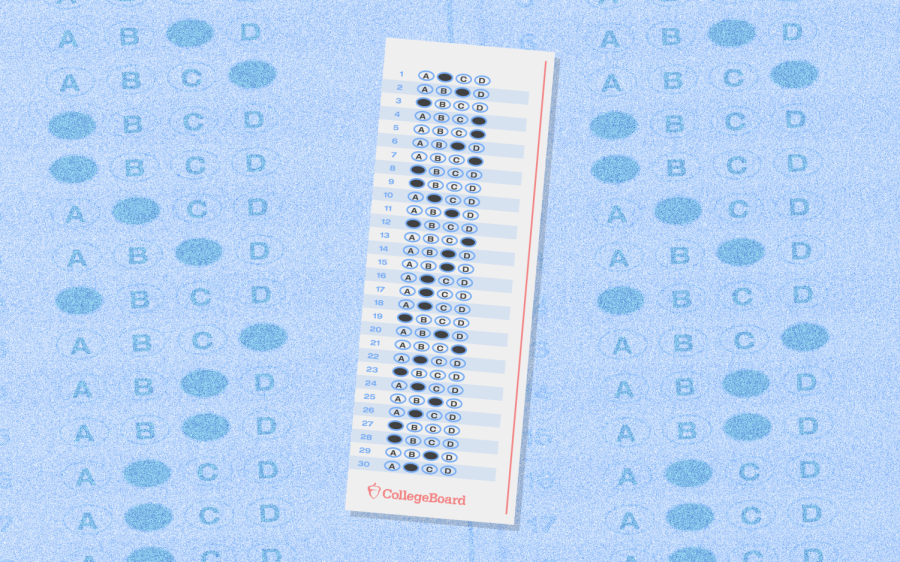Conquer the SAT with these tips
The SAT is hard, but with practice, it can be mastered
Following these tips may help ease your anxiety during next week’s state testing, and lead to your best score yet.
As we approach testing week, student anxiety surrounding the SAT may begin to feel overwhelming. While the SAT is designed to be a difficult exam, there is no need to worry as long as students come in prepared. The SAT tests very specific skill sets, and those skills can be developed through answering many practice questions with timely feedback. With the right amount of practice time and dedication, any student can get a score that they will be proud of. Both us were able to improve our scores greatly using these tips:
Reading – 52 Questions in 65 Minutes
Your job as a test taker is not to thoroughly understand the entirety of the five passages; all you have to do is accurately answer the questions. It is helpful to preview the questions for each passage before reading, making sure to underline important words or passages. Next, read the passage as fast as possible while maintaining comprehension. Although the text may seem dull or abstract, you should pretend for just a couple of minutes that the subject of the passage is the most interesting thing in the world. Fake it until you make it. Some questions will be much more difficult than others. Everything that is needed to correctly answer is hidden somewhere in the text, meaning that you should rely on evidence rather than unsupported inferences. Steer clear of deliberating over one question for too long. Also, the College Board loves to set traps by making part of an answer choice correct, but some other aspect of it slightly wrong. Even one word can invalidate an answer. These traps can best be avoided by using the process of elimination rather than simply looking for the answer that sounds right. Reading is often the most challenging section for students, but completing a few practice tests may improve both accuracy and time management. There are always some tricky questions, but students can get a better feel for the structure of these questions by reviewing their mistakes.
Writing & Language – 44 Questions in 35 Minutes
With an average time of less than a minute per question, the writing & language section of the SAT can seem scary. However, there are some ways to make it much easier. For one, read all of the passages in detail. This may seem wasteful to an unseasoned test taker, but a deeper understanding of the passage can assist in some context-oriented questions. On top of that, know your relevant grammar and punctuation rules well. It is important to master subject-verb agreement, conjugations, standard English conventions, the functions of different punctuation, and more. Many questions on this section require a strong basis in these fundamental skills, and memorizing them to the best of your ability will let you confidently breeze through those questions. Another crucial concept is transition phrases; each phrase has a unique purpose that may or may not match with the function of the sentence. Other types of questions may present several choices for how to reword a sentence. In addition to syntax, considering the context and author’s tone will guide you to the right answer—the sentence should be consistent with the rest of the passage. Also, be wary of needlessly long answers. If one choice is the shortest and it still makes sense, it is very often the correct answer. Concision is key. With a solid basis in these skill sets, students can overcome the writing & language section.
Math – 20 Questions in 25 Minutes (No Calc) & 38 Questions in 55 Minutes (Calc)
Everything you’ve learned in mathematics has prepared you for the math section of the SAT. The SAT mostly pulls from Algebra and Geometry, but you also may see questions from trigonometry and statistics. Like the other sections on the SAT, your score on the math section will be heavily dependent on your time management skills. With only a little more than one minute per question, you will need to work rather quickly—if you are confused with a question, move on and circle back later. All test takers will have questions that will stump them, but learning to move on is an acquired skill. It is also important to be able to recognize question types—some questions can be solved very simply but in an abstract way, while others may require lots of computation. A practiced test taker will be able to identify to which category a question belongs and solve accordingly. Like most things, your SAT score is heavily dependent on practice. Make sure to become comfortable answering questions from a variety of topics. A final tip is to become comfortable with your calculator; learning how to graph and set up equations quickly will improve your score.
With these tips in mind, consider checking out some helpful resources that may boost your confidence on the SAT.

Hi, my name is Ben Saperstein and I am an Editor in Chief for The Hawkeye. I am in my senior year and this is my 3rd year on staff. Outside of the The...

Hi, my name is Hayden Buckfire and I am a Managing Editor for The Hawkeye. I am in my senior year and this is my third year on staff. Outside of the Hawkeye,...

Hi, my name is Niranjan Anantharaman and I am the design editor for The Hawkeye. I am in my senior year and this is my second year on staff. Outside of...








